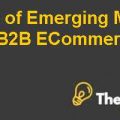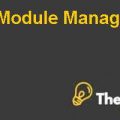
Elements and Participants in E-procurement Supply Chain Management
E-procurement is also referred to as supplier exchange method deals with the businesses for B2B, B2C, and with the government for the purchase and sale of suppliers through the use of internet technology. However, the process is also used for the interchanging of the electronic data and for the Enterprise Resource Planning. The main concept of e-procurement is to develop a platform where the buyer and sellers of goods and services could be registered. Regular purchases by customers could give them special discounts on the price and volume. The process of e-procurement is linked with the purchaser-to-pay (P2P) network to increase value chain which focuses on making the supply chain management through an online system. The value chain model for e-procurement consists of mainly indent management, e-tendering, and contract management. The approvals and the sanctions could only be obtained through electronic format.
The six types of e-procurement steps have been described below:
Web-based ERP: This process enables the purchasing and the creation of purchasing requisitions, and also requires the use of the internet technology to purchase and receive goods.
E-MRO: The process is referred to as Maintenance, Repair, and Overhaul which is similar to the concept of ERP except for the fact that it consists of non-product goods and products which are related to its MRO supplies.
E-Sourcing: This process is based on identifying new suppliers while maintaining the purchasing requirements through the use of internet technology.
E-Tendering:This is the process in which the flow of requests for prices and information is transferred from the sender to the receiver, and then back to the sender while using internet technology.
E-reverse Auctioning:It is a process in which a customer buys goods and services from the internet either from a known supplier or from the unknown supplier.
E-informing:The process of e-informing is the sharing and distributing of informationbetween the internal and external parties through the use of internet technology.
E-procurement Systems in Supply Chain Management
Best Practices in E-Procurement
Many companies and individuals have well-though strategies for the implementation of e-procurement for their businesses which has resulted them a long term sustainability. These strategies have been developed in terms of phases, where each phase carried out in the business provides an opportunity for learning the lessons. However, the best practices for e-procurement have many things in common which has allowed companies to achieve long term success which have been described below:
- A complete support from the top management regarding their funding and resources is been made available to the company so that it could help in maintaining compliance.
- The end users comfort and acceptance for the use of the system is an important element in enhancing the value of consumers and suppliers which has resulted in the leading factor towards success of many companies.
- The acceptance of e-procurement system has been failed due to failing the acceptance of the change management model. Underestimating the change model will restrict the flexibility of departments and individuals to perform change in an organization.
- The processes must be ensured and shall be checked for relevancy before conducting any automated solutions which would provide an idea about the impact of software upon the user.
- Breaking-up of the e-procurement technologies and processes along with checking up their metrics to ensure that the measuring cost and process efficiency is working fine and is clearly defined.
Challenges
At the initial phases of e-procurement, many businesses did not measure the time, effort, and the resources required for conducting the electronic transactions successfully. Currently, all parties that are involved in electronic e-procurement makes the process easier, simpler, and cost effective in order to get rid of the complexities of the system through using supplier enablement program. This program only maintains a strong emphasis on making the system cost effective. The other challenge faced by e-procurement includes the adoption of its users. It is a natural phenomenon in internet culture that an entire business unit would resist the change if changes are being made in flexibility and arein the favor buying power. Even though the pace and growth of e-procurement system has increased rapidly over the years but it still holds back the user adoption. These discrepancies include the spending nature of the user, inconsistent purchase requirements, lack of following procedures, and many others.................................
This is just a sample partial case solution. Please place the order on the website to order your own originally done case solution.













